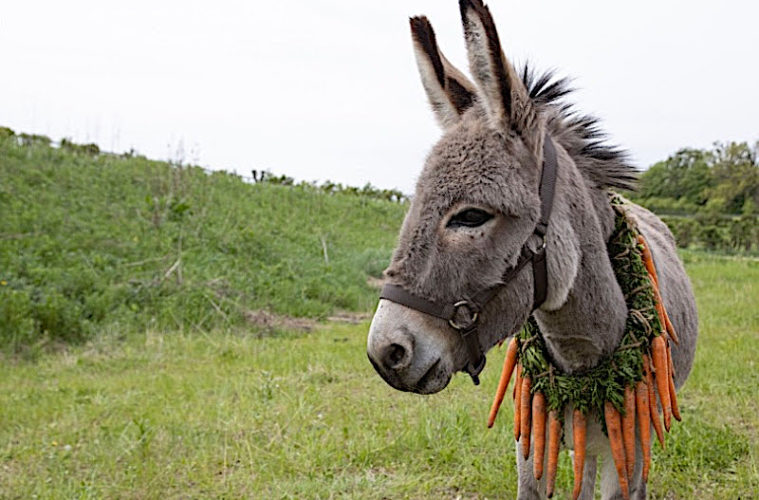 Jerzy Skolimowski’s EO lands like a defibrillator to the chest, a jolting and immediate dose of cinematic verve designed to shock the stupefied viewer out of complacency and restore a normal heartbeat. As simple and powerful as Au Hasard Balthazar, Robert Bresson’s animal film for art-house habitués, EO uses the central conceit of that 1966 classic as a jumping off point to spin a parable about a gentle donkey and his misadventures across modern Europe. It premiered earlier this year at Cannes, where it won the Jury Prize, and is now in limited release.
Jerzy Skolimowski’s EO lands like a defibrillator to the chest, a jolting and immediate dose of cinematic verve designed to shock the stupefied viewer out of complacency and restore a normal heartbeat. As simple and powerful as Au Hasard Balthazar, Robert Bresson’s animal film for art-house habitués, EO uses the central conceit of that 1966 classic as a jumping off point to spin a parable about a gentle donkey and his misadventures across modern Europe. It premiered earlier this year at Cannes, where it won the Jury Prize, and is now in limited release.
Trained at the Lodz Film School in Poland (where Roman Polanski was a classmate) before the days of Steadicam and CGI, Skolimowski is one of the last of an ancient breed of cinema nonconformists. A 17-year hiatus from filmmaking during which he became an internationally recognized painter ended in 2008 at the age of 70. Now in his ninth decade, the director is enjoying a remarkable second wind that’s yielded some of his strongest work to date. EO, which he co-wrote with his wife and creative partner, Ewa Piaskowska, is the fruit of a seed planted more than five decades ago, when Balthazar became the only film to make him shed tears.
The story begins in Poland, where the title creature—whose name references the bray of a mule—labors as a circus attraction. Animal rights protestors set into motion a legal procedure that separates EO from his home and the girl (Sandra Drzymalska) who cares for him, after which he is passed from owner to owner, suffering numerous captures and escapes. One poignant episode finds him stranded in the woods among wolves, who are subsequently stalked by unseen hunters with green lasers fixed to their rifles. In another, he witnesses a soccer rivalry that explodes into a senseless riot.
The idea of a common farm animal that soulfully witnesses human cruelty could only work in the hands of a master storyteller. Supremely confident, Skolimowski employs a variety of gripping visual and aural techniques that sustain attention for the entirety of the film’s 86-minute runtime. Bulging close-ups of the animal’s face command empathetic engagement from the viewer. Blurred edges of the frame suggest subjectivity. Flashbacks grant access to EO’s thoughts, and at one point, the restricted narration is broken with a series of breathtaking drone movements against a blood-red sky. Shot over a two-year period (thanks, COVID) with three different cinematographers, the film flaunts a wonderfully eclectic yet cohesive style that imbues the simple storyline with a consistent visual intensity. Pawel Mykietyn’s thunderous score is an achievement in itself; a deftly variegated soundtrack that brings emotional color to a range of situations.
Whether intended as a critique of the European meat industry, or a simple plea for kindness to animals, EO transcends the boundaries of social commentary to become a holy quest. Through the eyes of this simple beast, Skolimowski traverses the modern world and finds it spiritually lacking. A key moment involving a young priest (Lorenzo Zurzolo) and a woman later revealed to be his stepmother (Isabelle Huppert, in a characteristically intense cameo) offers a sharp examination of contemporary society. A chilling interlude depicting a robot dog’s uncanny gait reawakens our preference for nature and beauty over mechanization.
Although Skolimowski lacks Bresson’s distinctly Christian sensibility, EO is a singular and accomplished work in its own right, tender but not maudlin, pessimistic but not nihilistic, grand and even visionary. What could have been a mawkish sermon is transformed by Skolimowski’s total commitment to the material. In an era where detachment is cinematically fashionable, it’s refreshing to see a filmmaker so passionately engaged with his subject matter, and so willing to go the limit.
Editor’s note: The disclaimer below refers to advertising posts and does not apply to this or any other editorial stories. LA Weekly editorial does not and will not sell content.
Advertising disclosure: We may receive compensation for some of the links in our stories. Thank you for supporting LA Weekly and our advertisers.

